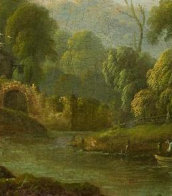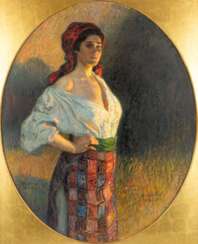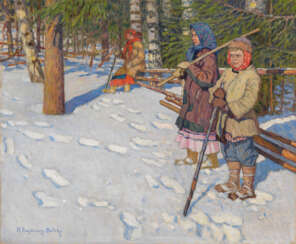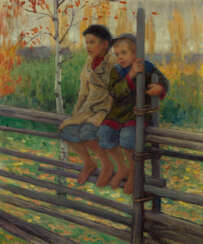Nikolay Petrovich Bogdanov-Belsky (1868 - 1945) — Auction price
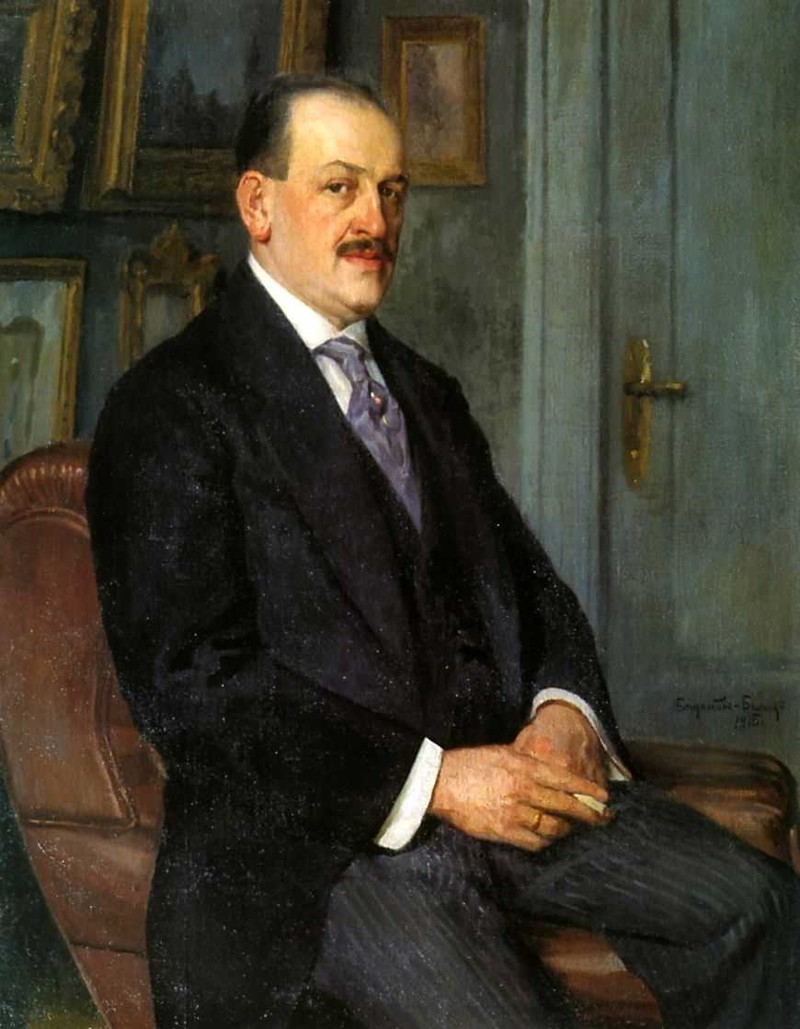
Nikolay Petrovich Bogdanov-Belsky (Russian: Николай Петрович Богданов-Бельский) was a renowned Russian artist, celebrated for his genre paintings depicting the education of peasant children, as well as portraits and impressionistic landscapes. Born in 1868 in Shitiki, Smolensk Governorate, Bogdanov-Belsky added "Belsky" to his surname from the district where he was born. His academic journey in art began at the Semyon Rachinsky fine art school, followed by studies at the Moscow School of Painting, Sculpture and Architecture, and later at the Imperial Academy of Arts in St. Petersburg.
Throughout his career, Bogdanov-Belsky was an active participant in Russian artistic circles, becoming a member of the Peredvizhniki from 1895 and the Arkhip Kuindzhi Society from 1909. His works often centered around the themes of rural education and childhood, capturing the subtle interplay of light and shadow and the innocence of his subjects. Notable works include "Mental Arithmetic, in the Rachinsky School" (1895) and "Sunday reading in a village school" (1895), which reflect his deep engagement with the theme of education.
After the Soviet Union came into power, the political climate and the disfavor towards realism compelled him to move to Riga, Latvia in 1921, where he continued his artistic endeavors until his death in Berlin in 1945 due to an Allied bombing during World War II.
For collectors and enthusiasts of Russian art, Bogdanov-Belsky's works offer a poignant glimpse into pre-Soviet Russian culture and education. His paintings are not only aesthetically pleasing but also historically significant, capturing the essence of a bygone era. To stay updated on sales and auction events featuring works by Nikolay Petrovich Bogdanov-Belsky, consider signing up for updates. This subscription will ensure you are informed about new opportunities to acquire pieces by this illustrious artist.
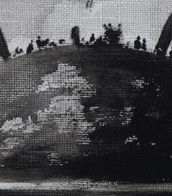

Nikolay Petrovich Bogdanov-Belsky (Russian: Николай Петрович Богданов-Бельский) was a renowned Russian artist, celebrated for his genre paintings depicting the education of peasant children, as well as portraits and impressionistic landscapes. Born in 1868 in Shitiki, Smolensk Governorate, Bogdanov-Belsky added "Belsky" to his surname from the district where he was born. His academic journey in art began at the Semyon Rachinsky fine art school, followed by studies at the Moscow School of Painting, Sculpture and Architecture, and later at the Imperial Academy of Arts in St. Petersburg.
Throughout his career, Bogdanov-Belsky was an active participant in Russian artistic circles, becoming a member of the Peredvizhniki from 1895 and the Arkhip Kuindzhi Society from 1909. His works often centered around the themes of rural education and childhood, capturing the subtle interplay of light and shadow and the innocence of his subjects. Notable works include "Mental Arithmetic, in the Rachinsky School" (1895) and "Sunday reading in a village school" (1895), which reflect his deep engagement with the theme of education.
After the Soviet Union came into power, the political climate and the disfavor towards realism compelled him to move to Riga, Latvia in 1921, where he continued his artistic endeavors until his death in Berlin in 1945 due to an Allied bombing during World War II.
For collectors and enthusiasts of Russian art, Bogdanov-Belsky's works offer a poignant glimpse into pre-Soviet Russian culture and education. His paintings are not only aesthetically pleasing but also historically significant, capturing the essence of a bygone era. To stay updated on sales and auction events featuring works by Nikolay Petrovich Bogdanov-Belsky, consider signing up for updates. This subscription will ensure you are informed about new opportunities to acquire pieces by this illustrious artist.
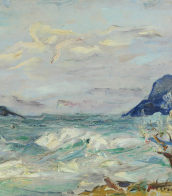

Nikolay Petrovich Bogdanov-Belsky (Russian: Николай Петрович Богданов-Бельский) was a renowned Russian artist, celebrated for his genre paintings depicting the education of peasant children, as well as portraits and impressionistic landscapes. Born in 1868 in Shitiki, Smolensk Governorate, Bogdanov-Belsky added "Belsky" to his surname from the district where he was born. His academic journey in art began at the Semyon Rachinsky fine art school, followed by studies at the Moscow School of Painting, Sculpture and Architecture, and later at the Imperial Academy of Arts in St. Petersburg.
Throughout his career, Bogdanov-Belsky was an active participant in Russian artistic circles, becoming a member of the Peredvizhniki from 1895 and the Arkhip Kuindzhi Society from 1909. His works often centered around the themes of rural education and childhood, capturing the subtle interplay of light and shadow and the innocence of his subjects. Notable works include "Mental Arithmetic, in the Rachinsky School" (1895) and "Sunday reading in a village school" (1895), which reflect his deep engagement with the theme of education.
After the Soviet Union came into power, the political climate and the disfavor towards realism compelled him to move to Riga, Latvia in 1921, where he continued his artistic endeavors until his death in Berlin in 1945 due to an Allied bombing during World War II.
For collectors and enthusiasts of Russian art, Bogdanov-Belsky's works offer a poignant glimpse into pre-Soviet Russian culture and education. His paintings are not only aesthetically pleasing but also historically significant, capturing the essence of a bygone era. To stay updated on sales and auction events featuring works by Nikolay Petrovich Bogdanov-Belsky, consider signing up for updates. This subscription will ensure you are informed about new opportunities to acquire pieces by this illustrious artist.


Nikolay Petrovich Bogdanov-Belsky (Russian: Николай Петрович Богданов-Бельский) was a renowned Russian artist, celebrated for his genre paintings depicting the education of peasant children, as well as portraits and impressionistic landscapes. Born in 1868 in Shitiki, Smolensk Governorate, Bogdanov-Belsky added "Belsky" to his surname from the district where he was born. His academic journey in art began at the Semyon Rachinsky fine art school, followed by studies at the Moscow School of Painting, Sculpture and Architecture, and later at the Imperial Academy of Arts in St. Petersburg.
Throughout his career, Bogdanov-Belsky was an active participant in Russian artistic circles, becoming a member of the Peredvizhniki from 1895 and the Arkhip Kuindzhi Society from 1909. His works often centered around the themes of rural education and childhood, capturing the subtle interplay of light and shadow and the innocence of his subjects. Notable works include "Mental Arithmetic, in the Rachinsky School" (1895) and "Sunday reading in a village school" (1895), which reflect his deep engagement with the theme of education.
After the Soviet Union came into power, the political climate and the disfavor towards realism compelled him to move to Riga, Latvia in 1921, where he continued his artistic endeavors until his death in Berlin in 1945 due to an Allied bombing during World War II.
For collectors and enthusiasts of Russian art, Bogdanov-Belsky's works offer a poignant glimpse into pre-Soviet Russian culture and education. His paintings are not only aesthetically pleasing but also historically significant, capturing the essence of a bygone era. To stay updated on sales and auction events featuring works by Nikolay Petrovich Bogdanov-Belsky, consider signing up for updates. This subscription will ensure you are informed about new opportunities to acquire pieces by this illustrious artist.
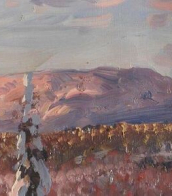

Nikolay Petrovich Bogdanov-Belsky (Russian: Николай Петрович Богданов-Бельский) was a renowned Russian artist, celebrated for his genre paintings depicting the education of peasant children, as well as portraits and impressionistic landscapes. Born in 1868 in Shitiki, Smolensk Governorate, Bogdanov-Belsky added "Belsky" to his surname from the district where he was born. His academic journey in art began at the Semyon Rachinsky fine art school, followed by studies at the Moscow School of Painting, Sculpture and Architecture, and later at the Imperial Academy of Arts in St. Petersburg.
Throughout his career, Bogdanov-Belsky was an active participant in Russian artistic circles, becoming a member of the Peredvizhniki from 1895 and the Arkhip Kuindzhi Society from 1909. His works often centered around the themes of rural education and childhood, capturing the subtle interplay of light and shadow and the innocence of his subjects. Notable works include "Mental Arithmetic, in the Rachinsky School" (1895) and "Sunday reading in a village school" (1895), which reflect his deep engagement with the theme of education.
After the Soviet Union came into power, the political climate and the disfavor towards realism compelled him to move to Riga, Latvia in 1921, where he continued his artistic endeavors until his death in Berlin in 1945 due to an Allied bombing during World War II.
For collectors and enthusiasts of Russian art, Bogdanov-Belsky's works offer a poignant glimpse into pre-Soviet Russian culture and education. His paintings are not only aesthetically pleasing but also historically significant, capturing the essence of a bygone era. To stay updated on sales and auction events featuring works by Nikolay Petrovich Bogdanov-Belsky, consider signing up for updates. This subscription will ensure you are informed about new opportunities to acquire pieces by this illustrious artist.
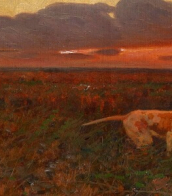

Nikolay Petrovich Bogdanov-Belsky (Russian: Николай Петрович Богданов-Бельский) was a renowned Russian artist, celebrated for his genre paintings depicting the education of peasant children, as well as portraits and impressionistic landscapes. Born in 1868 in Shitiki, Smolensk Governorate, Bogdanov-Belsky added "Belsky" to his surname from the district where he was born. His academic journey in art began at the Semyon Rachinsky fine art school, followed by studies at the Moscow School of Painting, Sculpture and Architecture, and later at the Imperial Academy of Arts in St. Petersburg.
Throughout his career, Bogdanov-Belsky was an active participant in Russian artistic circles, becoming a member of the Peredvizhniki from 1895 and the Arkhip Kuindzhi Society from 1909. His works often centered around the themes of rural education and childhood, capturing the subtle interplay of light and shadow and the innocence of his subjects. Notable works include "Mental Arithmetic, in the Rachinsky School" (1895) and "Sunday reading in a village school" (1895), which reflect his deep engagement with the theme of education.
After the Soviet Union came into power, the political climate and the disfavor towards realism compelled him to move to Riga, Latvia in 1921, where he continued his artistic endeavors until his death in Berlin in 1945 due to an Allied bombing during World War II.
For collectors and enthusiasts of Russian art, Bogdanov-Belsky's works offer a poignant glimpse into pre-Soviet Russian culture and education. His paintings are not only aesthetically pleasing but also historically significant, capturing the essence of a bygone era. To stay updated on sales and auction events featuring works by Nikolay Petrovich Bogdanov-Belsky, consider signing up for updates. This subscription will ensure you are informed about new opportunities to acquire pieces by this illustrious artist.


Nikolay Petrovich Bogdanov-Belsky (Russian: Николай Петрович Богданов-Бельский) was a renowned Russian artist, celebrated for his genre paintings depicting the education of peasant children, as well as portraits and impressionistic landscapes. Born in 1868 in Shitiki, Smolensk Governorate, Bogdanov-Belsky added "Belsky" to his surname from the district where he was born. His academic journey in art began at the Semyon Rachinsky fine art school, followed by studies at the Moscow School of Painting, Sculpture and Architecture, and later at the Imperial Academy of Arts in St. Petersburg.
Throughout his career, Bogdanov-Belsky was an active participant in Russian artistic circles, becoming a member of the Peredvizhniki from 1895 and the Arkhip Kuindzhi Society from 1909. His works often centered around the themes of rural education and childhood, capturing the subtle interplay of light and shadow and the innocence of his subjects. Notable works include "Mental Arithmetic, in the Rachinsky School" (1895) and "Sunday reading in a village school" (1895), which reflect his deep engagement with the theme of education.
After the Soviet Union came into power, the political climate and the disfavor towards realism compelled him to move to Riga, Latvia in 1921, where he continued his artistic endeavors until his death in Berlin in 1945 due to an Allied bombing during World War II.
For collectors and enthusiasts of Russian art, Bogdanov-Belsky's works offer a poignant glimpse into pre-Soviet Russian culture and education. His paintings are not only aesthetically pleasing but also historically significant, capturing the essence of a bygone era. To stay updated on sales and auction events featuring works by Nikolay Petrovich Bogdanov-Belsky, consider signing up for updates. This subscription will ensure you are informed about new opportunities to acquire pieces by this illustrious artist.
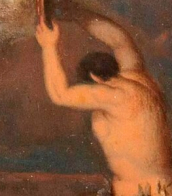

Nikolay Petrovich Bogdanov-Belsky (Russian: Николай Петрович Богданов-Бельский) was a renowned Russian artist, celebrated for his genre paintings depicting the education of peasant children, as well as portraits and impressionistic landscapes. Born in 1868 in Shitiki, Smolensk Governorate, Bogdanov-Belsky added "Belsky" to his surname from the district where he was born. His academic journey in art began at the Semyon Rachinsky fine art school, followed by studies at the Moscow School of Painting, Sculpture and Architecture, and later at the Imperial Academy of Arts in St. Petersburg.
Throughout his career, Bogdanov-Belsky was an active participant in Russian artistic circles, becoming a member of the Peredvizhniki from 1895 and the Arkhip Kuindzhi Society from 1909. His works often centered around the themes of rural education and childhood, capturing the subtle interplay of light and shadow and the innocence of his subjects. Notable works include "Mental Arithmetic, in the Rachinsky School" (1895) and "Sunday reading in a village school" (1895), which reflect his deep engagement with the theme of education.
After the Soviet Union came into power, the political climate and the disfavor towards realism compelled him to move to Riga, Latvia in 1921, where he continued his artistic endeavors until his death in Berlin in 1945 due to an Allied bombing during World War II.
For collectors and enthusiasts of Russian art, Bogdanov-Belsky's works offer a poignant glimpse into pre-Soviet Russian culture and education. His paintings are not only aesthetically pleasing but also historically significant, capturing the essence of a bygone era. To stay updated on sales and auction events featuring works by Nikolay Petrovich Bogdanov-Belsky, consider signing up for updates. This subscription will ensure you are informed about new opportunities to acquire pieces by this illustrious artist.


Nikolay Petrovich Bogdanov-Belsky (Russian: Николай Петрович Богданов-Бельский) was a renowned Russian artist, celebrated for his genre paintings depicting the education of peasant children, as well as portraits and impressionistic landscapes. Born in 1868 in Shitiki, Smolensk Governorate, Bogdanov-Belsky added "Belsky" to his surname from the district where he was born. His academic journey in art began at the Semyon Rachinsky fine art school, followed by studies at the Moscow School of Painting, Sculpture and Architecture, and later at the Imperial Academy of Arts in St. Petersburg.
Throughout his career, Bogdanov-Belsky was an active participant in Russian artistic circles, becoming a member of the Peredvizhniki from 1895 and the Arkhip Kuindzhi Society from 1909. His works often centered around the themes of rural education and childhood, capturing the subtle interplay of light and shadow and the innocence of his subjects. Notable works include "Mental Arithmetic, in the Rachinsky School" (1895) and "Sunday reading in a village school" (1895), which reflect his deep engagement with the theme of education.
After the Soviet Union came into power, the political climate and the disfavor towards realism compelled him to move to Riga, Latvia in 1921, where he continued his artistic endeavors until his death in Berlin in 1945 due to an Allied bombing during World War II.
For collectors and enthusiasts of Russian art, Bogdanov-Belsky's works offer a poignant glimpse into pre-Soviet Russian culture and education. His paintings are not only aesthetically pleasing but also historically significant, capturing the essence of a bygone era. To stay updated on sales and auction events featuring works by Nikolay Petrovich Bogdanov-Belsky, consider signing up for updates. This subscription will ensure you are informed about new opportunities to acquire pieces by this illustrious artist.


Nikolay Petrovich Bogdanov-Belsky (Russian: Николай Петрович Богданов-Бельский) was a renowned Russian artist, celebrated for his genre paintings depicting the education of peasant children, as well as portraits and impressionistic landscapes. Born in 1868 in Shitiki, Smolensk Governorate, Bogdanov-Belsky added "Belsky" to his surname from the district where he was born. His academic journey in art began at the Semyon Rachinsky fine art school, followed by studies at the Moscow School of Painting, Sculpture and Architecture, and later at the Imperial Academy of Arts in St. Petersburg.
Throughout his career, Bogdanov-Belsky was an active participant in Russian artistic circles, becoming a member of the Peredvizhniki from 1895 and the Arkhip Kuindzhi Society from 1909. His works often centered around the themes of rural education and childhood, capturing the subtle interplay of light and shadow and the innocence of his subjects. Notable works include "Mental Arithmetic, in the Rachinsky School" (1895) and "Sunday reading in a village school" (1895), which reflect his deep engagement with the theme of education.
After the Soviet Union came into power, the political climate and the disfavor towards realism compelled him to move to Riga, Latvia in 1921, where he continued his artistic endeavors until his death in Berlin in 1945 due to an Allied bombing during World War II.
For collectors and enthusiasts of Russian art, Bogdanov-Belsky's works offer a poignant glimpse into pre-Soviet Russian culture and education. His paintings are not only aesthetically pleasing but also historically significant, capturing the essence of a bygone era. To stay updated on sales and auction events featuring works by Nikolay Petrovich Bogdanov-Belsky, consider signing up for updates. This subscription will ensure you are informed about new opportunities to acquire pieces by this illustrious artist.
